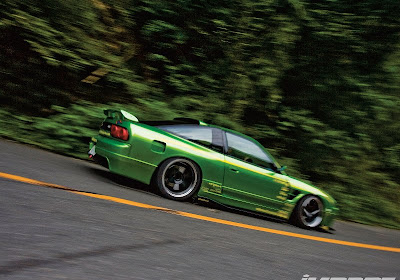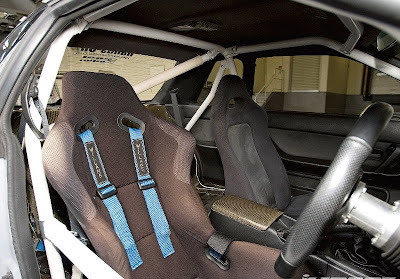2000 Nissan Silvia - Brave New World
Shubash Singh's brazen taken on the S15 Silvia is both humble and defiant--a refreshingly pleasing duality
Shubash Singh's '00 Nissan S15 Silvia is calm from the outside. With its factory gray casting back ominously, the exterior features an overly polite veneer that signals a potentially falsified sense of speed, power, and overall workmanship. The body modifications are not applicable, and Shubash is unapologetic about it all. Because just like the old maxim asserts, "Don't judge a book by its cover," his S15 is a crusty title-less paperback with coffee stains and dog-eared corners. The major separation of this underwhelming façade is the Silvia's pristinely planned, disco-ball-turning, massive guts.
Headgames Motorworks's Dave Localio first brought Shubash's car to our attention. I can remember the cold Tennessee night when I heard it start for the first time; it sounded strong and it rode well, but I couldn't get past its near-stock surface. "There has to be a reason why Dave, who builds four-digit-horsepower 2JZs for a living, like this thing," I reassured myself. And after a neck-whipping 70-140 freeway pull, I realized why. I was speechles, even after we pulled over to have a peak under the hood, and as the photographer muttered the words, "It's . . . beautiful!" I looked over and his face shone pure bliss. He was staring at the Silvia's SR20DET with magic in his eyes; the sight of the already ultimate motor fully developed was angelic. It was a moment of saccharine ecstasy, a spiritual connection through cars, and it's for those moments like that of unity between tuner and engine that the SR20 exists. Shubash is right in being unapologetic about the exterior.
"I grew up with a passion for cars and basically anything with wheels, from performance, sound, electronics, to appearance. I enjoy and fiddle with it all," Shubash said, "I bought this car because my father bought one some years back and I couldn't get enough drive time with it. The car handled and performed great in its stock state. The options and many ways you can go with this platform intrigued me and caught my interest. When I saw one for sale from a friend, I jumped and have been in it ever since." Much of that physical manifestation came from Shubash's father, who owned an auto sales and body shop when Shubash was growing up back in Trinidad. His father was also an avid street racer, flogging cars like the Datsun 1200, Mitsubishi Lancer GSR, and Mazda RX-7. This passion for cars, as well as the appreciation of the engine, transferred seamlessly into Shubash's life.
Everything in this Silvia was coordinated to an epic T, from the politeness of the exterior to the massive, velvety engine bay that cascades underneath the hood like a stage revealing Broadway performers. The engine alone cost around $15K in parts and labor. The motor's head is fully ported with a polished valve job, matched perfectly with the intake and exhaust manifold. Piping was customized for shorter runs with less aggressive angles, and the rotating assembly has been balanced. The 2.0-liter displacement remains intact but the compression ratio has been raised from 8.5:1 to 9.0:1. The stock turbo was upgraded with one from Precision, a model HP6262. The manifold is from Peakboost, with an equal-length T3 top mount, while the Greddy intercooler and pipes were customized to Shubash's liking and the boost controller was replaced with a Blitz Spec-R ICD-III version. All of which helps the Tomei Procam camshafts, Eagle H-Beam connecting rods, and CP pistons move a little faster to a tune of a firm, absurd loudness.
"I wanted to build this myself and see where I could push the envelope without sacrificing drivability and comfort. At the end of the day, I like driving the car," explained Shubash, "The most unique feature is the Tomei Reytec ECU; it takes me so long to explain to friends and strangers that Tomei, in fact, sells a stand-alone that is MAP-based for the SR20. It was this product and all the other unique ones that were the root of my frustration, waiting for them to arrive at my doorstep from shops around the country as well as Japan. In the end, of course, it was all worth it."
Working under the hood and the car overall, Shubash always found himself generally pleased, but wishing the S15 was tuned to a more perfect setting. He tooled around with several setups and in two years, he found a level ground in which he felt the car was at its tuning peak. He then focused on the ride to complete the build. He installed a set of Ksport Kontrol Pro coilovers, Nismo bushings and motor mounts, and a Kazama Hicas Stopper kit. The factory wheels were replaced with 18-inch Rays Gram Lights 57 Pros with a deep dish in the rear that seems to run endlessly. Behind the Gram Lights sit Brembo calipers with Rotora rotors in the front and Brembo rotors in the rear. Project Mu B-Force brake pads run on all four corners, as well as SPL stainless steel braided brake lines. The interior includes a svelte set of Bride Euro II front seats that face a custom gauge panel for the Defi and Innovate wide-band gauges between the radio and climate controls.
Among his team who worked on the car, including the people at MTR Racing and Headgames Motorworks, Shubash often refers to the build as "good times" and it is telling that he was so taken with the concept of goodness. What was an ideal car on paper, he has built into a gargantuan presence. "There are so many SR20s floating around, but few are really completely done. It was a gradual build, but it was so much fun to do," said Shubash. It's difficult to imagine any tuner finding much unhappiness in Shubash's S15, and if they did, they shouldn't expect Shubash to do much about it.
Tomei Reytec
The Gratuitous Sidebar That Rhymes with VTEC.
So what's this hubbub about the Tomei Reytec? To get to the bottom of this somewhat enigmatic ECU, we hit up Riki Endo, representative of Tomei USA.
According to Endo-san, "This programmable ECU is very popular in Japan due to its convenient software setting, A/F ratio adjustability, and mapping the ECU is done with ease. We also provide downloadable data on our website for the user! Thank you very much for giving us the opportunity to inform your readers about our Reytec system!"
No problem, buddy!
'00 Nissan Silvia
Engine
SR20DET; balanced rotating assembly, custom head porting; Tomei Procam camshafts, oil pan, throttle body, rocker arm stoppers, Reytec Hi-Boost, oil cap, polished compressor housing, multi-layer exhausts manifold gasket; Russell braided lines; Eagle H-Beam connecting rods; CP Pistons 9.0:1 pistons, piston rings; ARP head studs; Supertech valve kit, dual valve springs, titanium retainers; Greddy S15 Version 2 intake manifold, intercooler pipes, fuel rail, catch can; HKS Hi-Power exhaust, blow-off valve; Precision HP6262 V-band outlet turbocharger; Peakboost equal-length T3 top-mount turbo manifold; Tial wastegate; Blitz Spec-R IDC-III boost controller; Koyo aluminum radiator; JDM radiator hoses; Flex-a-Lite FAL-220 radiator fans; Enjuku Racing adjustable thermostat; Splitfire ignition; NGK spark plugs; Injector Dynamics ID1000 fuel injectors; Aeromotive A1000 fuel pressure regulator; Walbro and Bosch fuel pumps; Power Enterprise head gasket
Drivetrain
Ogura Racing Clutch kit; Nismo transmission mount
Suspension
Ksport Kontrol Pro coilovers; Nismo bushings, motor mounts; Kazama Hicas Stopper
Wheels/Tires
Rays Gram Lights 57 Pro Titanium wheels (18x9 front, 18x10 rear); Nitto NT-555 tires (235/40-18 front, 255/35-18 rear)
Brakes
Brembo calipers with Rotora 13-inch slotted rotors (front); Brembo calipers, rotors (rear); Project Mu B-Force pads; SPL stainless braided brake lines
Exterior
Stock
Interior
Bride Euro II seats; custom gauge panel
Electronics
Defi/Innovate gauges; Blitz/Defi displays; Eclipse iPod and navigation head unit, speakers; KnuKonceptz wiring; Optima Battery relocated to trunk
Name.
Shubash Singh
Shubash Singh
Age.
30
Hometown.
Nashville, TN
Occupation.
Programmer
Build time.
Two Years













































